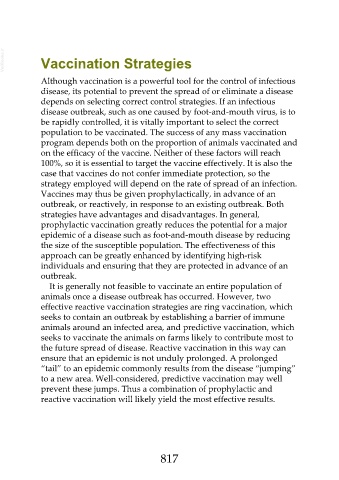Page 817 - Veterinary Immunology, 10th Edition
P. 817
VetBooks.ir Vaccination Strategies
Although vaccination is a powerful tool for the control of infectious
disease, its potential to prevent the spread of or eliminate a disease
depends on selecting correct control strategies. If an infectious
disease outbreak, such as one caused by foot-and-mouth virus, is to
be rapidly controlled, it is vitally important to select the correct
population to be vaccinated. The success of any mass vaccination
program depends both on the proportion of animals vaccinated and
on the efficacy of the vaccine. Neither of these factors will reach
100%, so it is essential to target the vaccine effectively. It is also the
case that vaccines do not confer immediate protection, so the
strategy employed will depend on the rate of spread of an infection.
Vaccines may thus be given prophylactically, in advance of an
outbreak, or reactively, in response to an existing outbreak. Both
strategies have advantages and disadvantages. In general,
prophylactic vaccination greatly reduces the potential for a major
epidemic of a disease such as foot-and-mouth disease by reducing
the size of the susceptible population. The effectiveness of this
approach can be greatly enhanced by identifying high-risk
individuals and ensuring that they are protected in advance of an
outbreak.
It is generally not feasible to vaccinate an entire population of
animals once a disease outbreak has occurred. However, two
effective reactive vaccination strategies are ring vaccination, which
seeks to contain an outbreak by establishing a barrier of immune
animals around an infected area, and predictive vaccination, which
seeks to vaccinate the animals on farms likely to contribute most to
the future spread of disease. Reactive vaccination in this way can
ensure that an epidemic is not unduly prolonged. A prolonged
“tail” to an epidemic commonly results from the disease “jumping”
to a new area. Well-considered, predictive vaccination may well
prevent these jumps. Thus a combination of prophylactic and
reactive vaccination will likely yield the most effective results.
817

